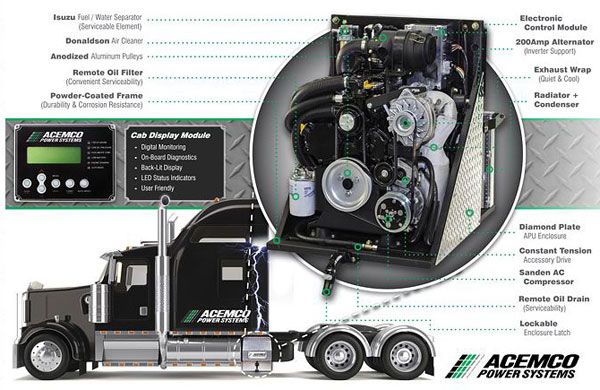Having A Truck Without An APU
Topic 18343 | Page 1
All kinds of power inverters...up to 400-450 watts that plug in 12V or much more if wired directly to battery. It's up to your company as to which way they let you do it but just a laptop, tv or small stuff the 400 watts should be fine. If you're talking microwave you'll need a little more I think. I run a 410 watt and its fine for my tv tablet and such.

All kinds of power inverters...up to 400-450 watts that plug in 12V or much more if wired directly to battery. It's up to your company as to which way they let you do it but just a laptop, tv or small stuff the 400 watts should be fine. If you're talking microwave you'll need a little more I think. I run a 410 watt and its fine for my tv tablet and such.
Thanks, any difficultly setting it up?
LTL:
Less Than Truckload
Refers to carriers that make a lot of smaller pickups and deliveries for multiple customers as opposed to hauling one big load of freight for one customer. This type of hauling is normally done by companies with terminals scattered throughout the country where freight is sorted before being moved on to its destination.
LTL carriers include:
- FedEx Freight
- Con-way
- YRC Freight
- UPS
- Old Dominion
- Estes
- Yellow-Roadway
- ABF Freight
- R+L Carrier
Thanks, any difficultly setting it up?
Just plug it in to one of the 12 volt outlets in your truck.
LTL:
Less Than Truckload
Refers to carriers that make a lot of smaller pickups and deliveries for multiple customers as opposed to hauling one big load of freight for one customer. This type of hauling is normally done by companies with terminals scattered throughout the country where freight is sorted before being moved on to its destination.
LTL carriers include:
- FedEx Freight
- Con-way
- YRC Freight
- UPS
- Old Dominion
- Estes
- Yellow-Roadway
- ABF Freight
- R+L Carrier

Thanks, any difficultly setting it up?
Just plug it in to one of the 12 volt outlets in your truck.
Cool, first time getting one so bear with me.
Do you know if they run on their on supply source? Because it might drain the truck battery much quicker.
LTL:
Less Than Truckload
Refers to carriers that make a lot of smaller pickups and deliveries for multiple customers as opposed to hauling one big load of freight for one customer. This type of hauling is normally done by companies with terminals scattered throughout the country where freight is sorted before being moved on to its destination.
LTL carriers include:
- FedEx Freight
- Con-way
- YRC Freight
- UPS
- Old Dominion
- Estes
- Yellow-Roadway
- ABF Freight
- R+L Carrier

Yes, you can get inverters that plug into the 12v outlets. They get their power from the same source as everything else in the truck... batteries when it is shut off and batteries and alternator when it is running. So, yes, it will run down the batteries during use. Intermittent use should be okay and almost every truck in the last 10-ish years has a power disconnect that kicks in if the batteries drop below the threshold for starting the truck. What happens is it will disconnect all the power to the sleeper and other non-essential circuits. Keep in mind, though, that this is a "safety" device that may, or may not, be active in your truck, it may, or may not, be calibrated correctly and it typically is designed for when you are starting your truck in "optimal" conditions (no drag on engine, unclogged fuel filters, not -30 degrees, no additional parasitic electrical draw, fully charged and healthy batteries, etc.). These switches automatically reset once the truck is started.
As for plug-in inverters, although I have used them for many, many years, you have to be careful and I do not recommend them for constant, nor continuous, use. I have used them primarily to run a laptop and printer, charge batteries for flashlights and headlamps, etc. Nor are they recommended for high-draw appliances (more on this later). I recommend a maximum 300 watt inverter (more on this below).
Inverters are rated by wattage output. To determine what size inverter you need, you have to determine what the current draw is of any electrical accessories you will be plugging in. Every electrical device will have a tag that tells you what either the wattage or amperage (amps) draw is, plus the voltage. If it is amps you can convert it to watts by the following formula: Watts = Amps * Volts (this is a quick 'n dirty calculation, but since we're not designing a factory or machinery it will be just fine). W = A * V W = 7.5 * 120 W = 900 More than a plug-in inverter will supply. What if you have something like a microwave, or curling iron? Assuming you have something like a 700 watt microwave it should be fine plugged into a 900 watt inverter, right? Not so fast.
A couple more things to consider; 1) the "watt" rating of a microwave is typically not the true electrical draw (due to inherent inefficiencies), see the tag on the back / bottom, also 2) anything with a motor will have an initial spike (motor start-up) that will exceed the noted draw and so you want to factor that in. For safety and performance I would typically add 25%. So, going back to the aforementioned "700 W" microwave, let's say it really draws 1000 watts. 1000 * 1.25 (plus 25%) = 1250 watts So, in this case, 1250 watts would be the minimum recommendation, but 1500 watts is better (produces less heat, lasts longer, etc.)
Now, the other VITALLY important thing to know is the maximum amp draw of the circuit you are plugging your inverter into. In most cases, if it is a 12 v plug-in, it will be 10-15 amps. This is limited by the manufacturer based on the components (most importantly, the wiring) used in construction. EXCEEDING THE MANUFACTURER'S LIMITS WILL PUT YOU AT RISK OF BURNING YOUR TRUCK DOWN... LIKELY WITH YOU IN IT. So, DO NOT put a bigger fuse in the circuit. To find out the amp draw, if not listed, use the following formula: Amps = Watts / Volts A = W / V Assuming 1000 watts and 120 volts A = 1000 / 120 A = 8.3
So far so good? Not quite. Remember the 25% safety factor above? I would apply the same to the amperage calculation. The reason being is that if you have a continuous 10 amp draw on a circuit with a 10 amp fuse you will run into it occasionally burning out the fuse (or tripping the breaker). Especially as wires get old, there is corrosion, too hot or too cold creates additional resistance, etc. 8.3 * 1.25 = 10.4 amps I would recommend a 15 amp circuit.
Most decent inverters will have either a shut-off or alarm if you try and exceed the current draw for either the circuit it is plugged into, or the inverter output. However, again, it is best not to rely on this and to have the proper equipment and use it within its design specifications.
So now you're asking, "But how do I cook my dinner AND watch TV at the same time?" You don't. Well, you can IF you have a big enough inverter and it is PROPERLY installed. For anything over about a 300 watt inverter (big enough for a laptop or printer, but not big enough for a microwave, coffee maker, etc. Making heat takes a lot of energy). A PROPERLY installed large inverter will be wired directly to the batteries with wires/cables sufficient enough for the current draw (my preference is to use welding cables). There will also be a fuse in the line to the inverter (VITAL) and a shut-off switch.
Finally, a word on inverter types. You will see some inverters called Pure Sine Inverters. These are usually 2-3 times more expensive than your typical, "normal" inverter (aka: Modified Sine Inverter) you might buy at a truck stop or low-end electronics store. They are designed with better components and filters and produce "better" current (less noise, fewer spikes, etc.) I have never used one and I have never had a problem. However, if you have some expensive electronics plugged directly into your inverter (not via a transformer like your typical laptop or printer), or you're an audiophile, you may want to use a Pure Sine Inverter.
OWI:
Operating While Intoxicated

Just remember, big inverters draw big power and can deplete your batteries quickly under continuous use. My recommendation is to run the engine (or APU) when doing something like cooking a meal or making coffee. Then you can shut off the engine and eat your meal in peace-and-quiet while surfing the web with your laptop plugged in.
APU:
Auxiliary Power Unit
On tractor trailers, and APU is a small diesel engine that powers a heat and air conditioning unit while charging the truck's main batteries at the same time. This allows the driver to remain comfortable in the cab and have access to electric power without running the main truck engine.
Having an APU helps save money in fuel costs and saves wear and tear on the main engine, though they tend to be expensive to install and maintain. Therefore only a very small percentage of the trucks on the road today come equipped with an APU.


Just remember, big inverters draw big power and can deplete your batteries quickly under continuous use. My recommendation is to run the engine (or APU) when doing something like cooking a meal or making coffee. Then you can shut off the engine and eat your meal in peace-and-quiet while surfing the web with your laptop plugged in.
Thanks for sharing your knowledge on the subject. The issue I have with my truck is it doesn't idle when it's cold.
Any suggestions?
APU:
Auxiliary Power Unit
On tractor trailers, and APU is a small diesel engine that powers a heat and air conditioning unit while charging the truck's main batteries at the same time. This allows the driver to remain comfortable in the cab and have access to electric power without running the main truck engine.
Having an APU helps save money in fuel costs and saves wear and tear on the main engine, though they tend to be expensive to install and maintain. Therefore only a very small percentage of the trucks on the road today come equipped with an APU.


Not4Hire:
You're an amateur radio (ham) operator aren't you? I have been one for about 25 years and never have I ran into someone who didn't work in the electronics field be able to pull those formulas out of their hat on a moment's notice unle4ss they were a ham.
HOS:
Hours Of Service
HOS refers to the logbook hours of service regulations.
Not4Hire:
You're an amateur radio (ham) operator aren't you? I have been one for about 25 years and never have I ran into someone who didn't work in the electronics field be able to pull those formulas out of their hat on a moment's notice unle4ss they were a ham.
LOL my thoughts exactly. Nobody else can blithely spit out terms like "modified sine wave."
HOS:
Hours Of Service
HOS refers to the logbook hours of service regulations.New Reply:
New! Check out our help videos for a better understanding of our forum features

















Preview:
This topic has the following tags:
Advice For New Truck Drivers Cell Phone & Wireless Cooking In The Truck Entertainment Truck Driving Lifestyle Truck Equipment







 TT On Facebook
TT On Facebook
Is there anything I can use to have steady electricity in my truck? My last company had one and it's a different ball game with one now.
Plus I was planning to bring my laptop as well. Any help is appreciated.